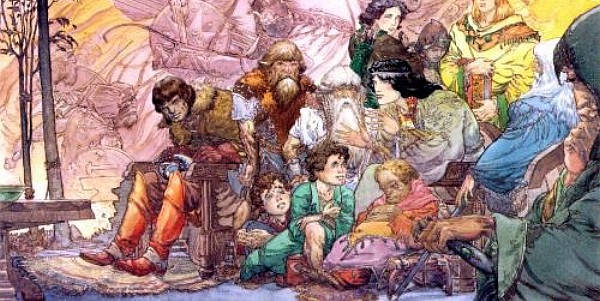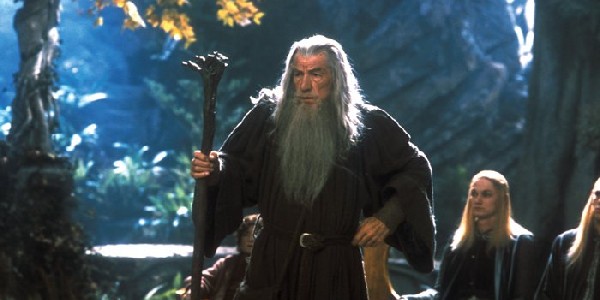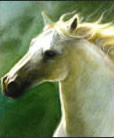2.02. The Council of Elrond by Figwit

How did it happen in the movie?
The Council of Elrond is held to decide the faith of the Ring. Representatives of all the free peoples of Middle Earth have been assembled, amongst them the Elf Legolas of Mirkwood, the Dwarf Gimli of Erebor and Boromir, a Man of Gondor. Gandalf and Strider are also present, as is Frodo who seems to feel a little out of place.
When the Ring is revealed to the others, Boromir suggests they’d keep it and use it to defend Gondor. In the dispute that follows, Strider is revealed as Aragorn, the heir of Isildur and to the throne of Gondor, much to Boromir’s surprise and dismay.
Elrond makes it clear that the Ring cannot be destroyed safe by throwing it into the fires where it was made, and Frodo volunteers to continue his journey as Ring-bearer. At that Gandalf, Aragorn, Legolas, Gimli and Boromir all pledge their allegiance to the Hobbit.
Sam, who has been lurking in the bushes, and Merry and Pippin, who had been hiding inside the house, demand to accompany their friends – and Elrond concludes the meeting by naming the company ‘the Fellowship of the Ring’.

How did it happen in the book?
The morning after the feast, Frodo encounters Bilbo and Gandalf in the gardens of Rivendell. He accompanies them to a council to which he had been summoned before and where he meets tons of new and old characters.
Roughly, this chapter consists of several more or less ‘separate’ parts: first Elrond listens to the tale of the Dwarves (as told by Glóin) about the disappearance of Balin who went to Moria to reclaim it, and about the messenger from Mordor who appeared in Erebor asking questions about Bilbo and the Ring, promising to return some of the Dwarven Rings of Power to King Dáin.
Then Elrond and Gandalf tell the story of the Ring, with interruptions by Boromir of Gondor (who came to Rivendell to seek council from Elrond after he and his brother Faramir had vision-like dreams) and Aragorn who reveals himself as Isildur’s heir. We learn from Gandalf about the treason of Saruman, his imprisonment in and escape from Orthanc and what happened to Gollum. Legolas then informs the council of his errand, being to inform Elrond of Gollum’s escape from Mirkwood.
After the entire story is told, the council discusses what should happen to the Ring. There are several suggestions: to use it – or at least one of the lesser Rings (a popular idea amongst the Dwarves and with Boromir), to cast it in the River and to give it to Tom Bombadil. However, when it becomes obvious that the only option is the complete destruction of the Ring in the fires of Mount Doom, Bilbo and afterwards Frodo volunteer to take the Ring. Sam, who was silently present all the time, steps in and demands to go with his master.
There was a lot of information in this chapter, some of it extremely important and necessary to understand the story, some of it adding to the characters or the detail and some of it merely detailing the details of an already pretty detailed background story.
It’s no surprise that this scene, which is basically a bunch of people telling each other stories about events most of them didn’t even play a part in, was drastically shortened. However, some information was still used in the movie: most of the information used in the Prologue was taken directly from this scene, and the encounter between Saruman and Gandalf is also described here. But a lot was lost: the motivations for the character’s presence, the long talk about the importance and history of Gondor and the discussion about what can be done with the Ring.
With that, a lot of characters also vanished into honey-coloured thin air:
– Glóin, son of Gróin and father of Gimli. You can catch a glimpse of him when the party of Dwarves arrives, but at the council he is nowhere to be seen. The reasons why the Dwarves are at the meeting is not mentioned, allowing for Gimli to later advice Gandalf to travel through Moria.
– Glorfindel is not present at the council either. In the books, the great and noble Elf lord is presented as an important part of Elrond’s household.
– Bilbo isn’t at the council either. In the books the old Hobbit is asked to tell his tale of finding the Ring, and later he volunteers to carry the Ring to Mount Doom but has to admit to Elrond that in fact he may be a little to rusty for such a task. Bilbo is portrayed as someone of great importance, and treated with the utmost respect by the Elves of Rivendell and those present at the council (all save Boromir, who’s never seen a Hobbit in his entire life).
– Erestor, councillor to Elrond, and Galdor of the Grey Havens are not present either: they play an important part in the discussion of the fate of the Ring.
Let’s take a closer look at what does happen in the movie – because there too some changes have been made.
– In the introduction, Elrond says that all the members present have been summoned to Rivendell. However, in the books most of those attending the council had a strong motivation to be in Rivendell: the Dwarves wanted to win Elrond’s advice about Balin and Moria, and to tell him about the messenger of Sauron that came to Erebor; Galdor was there on an errand from Círdan; Legolas came as messenger from his father Thranduil and Boromir came to win advice about the dream he and his brother Faramir had. Only Gandalf and Frodo were there because of the Ring.
– Strider’s true identity and his lineage are revealed not by himself (as a response to Boromir’s dream) but by Legolas, who also declares that Aragorn is heir to the throne of Gondor. As is explained under mistakes, this is not absolutely true, and in the books Boromir does not accept this statement immediately, but his reaction is not nearly as defensive.
– Gimli doesn’t attempt to destroy the Ring with his axe. Gimli does very little if not nothing at the council: it’s Glóin that does most of the talking. And anyhow, everyone is too impressed by the sheer presence of the Ring to even come within arm’s range of it: so no Boromir trying to take it either.
– There is no quarrelling about listening to Lord Elrond or being dead before seeing the Ring in the hands of an Elf / Dwarf. Reference is made to the hospitality between the Elves and the Dwarves when Glóin answers Legolas’ tale about Gollum’s escape (which he blames on over-kindness) with ‘You were less tender to me’ (referring to events in ‘The Hobbit’) and Gandalf seals this debate with: ‘If all the grievances that stand between Elves and Dwarves are to be brought up here, we may as well abandon this Council’.
– The formation of the Fellowship does not take place at the council, but afterwards, during the long months in which scouts search the lands for news of the enemy. The only one who joins Frodo is Sam, who was not hiding behind the bushes but merely sitting quietly in a corner of the patio.

Mistakes
– Aragorn is not clad in his nice and kingly elvish garment, but in his Ranger outfit.
– Aragorn has no immediate claim to the throne of Gondor: he is the heir of Isildur who received from his father Elendil the northern realm of Arnor. The North-kingdom ended in 1975 of the Third Age with the death of Arvedui. The line of Isildur was continued, however they took on the position of Chieftain of the Dúnadain, the Rangers of the North.
The southern half of Elendil’s realm, Gondor, went to Isildur’s brother Anárion. This line of Kings ended in 2050 (TA) with the death or Eärnur. Gondor was further governed by the Stewards, the first of which being Mardil Voronwë.
In fact Steward Pelendur, who ruled Gondor for a year after the death of King Ondoher, refuted the claim of North-king Arvedui on Gondor, after the fall of Arnor; so there’s no reason why Aragorn II should hold any immediate claim over the South-kingdom.
The claim is legitimate though, since originally the South-kingdom was ‘shared’ between the brothers, and only after the death of both Elendil his father, and Anárion his brother, did Isildur become King of the North-Kingdom.
Furthermore, the line of Kings from the south has supposedly died out, though our Middle-earth Section had an essay by Cressida discussing ties between the royal family and the Stewards has been added, which discusses this matter more profoundly.
Borrowed Lines
– Legolas’ ‘He is Aragorn son of Arathorn’ originally belongs to Elrond.
– Boromir uses the lines ‘It is a gift, I say; a gift to the foes of Mordor.’ in 2.X. The Breaking Of the Fellowship.
– Another line of Boromir’s – ‘There is evil there that does not sleep. And the great Eye is ever watchful.’ – is derrived from a line of text from the same chapter, which reads: ‘There was an eye in the dark tower that did not sleep.’
– Merry’s ‘You’d have to send us home tied up in a sac to stop us!’ is actually a line that Pippin uses in 2.III to convince Gandalf to take them along.
– Merry’s response (‘Well, that rules you out, Pip’) to Pippin’s ‘You’ll need people of intelligence on this quest.’, is taken from the same chapter (The Ring Goes South): when Pippin says that ‘there must be someone with intelligence in the party’, Gandalf replies with ‘Then you will not be chosen, Peregrin Took!’.
- For more information about the changes in the characters, see the articles about Aragorn, Bilbo Baggins, Boromir, Elrond and the new character of Gimli.
- Information from this chapter was used in The Treason of Isengard and The Prologue.
Interesting Links
Our Gallery has screencaps of The Council of Elrond,as well as the extended edition with Boromir's attempt to touch the Ring and Gandalf citing the Ring-spell in the Black Tongue.
A transcript of Lord Of the Rings: Fellowship Of the Ring can be found in our Film Fun & Facts section.
A summary of Lord Of the Rings: Fellowship of the Ring can be found in Elrond's Library.
Some articles that are related to this sequence:
- For more information about Aragorn and his heritage, you can read A History of the Númenóreans, The Dúnedain of the North (both by Nienna-of-the-Valar) and The Sword of Elendil by Fossegrim, as well as look at his family tree.
- The Middle-earth section has some articles on The One Ring (by atalante_star), Boromir (by Figwit), Radagast and Saruman.
You can also read an account of the Battle of the Last Alliance.
Forum threads related to this sequence:
- The Movie Forum has a Sequence by Sequence thread about this scene, where you can voice your opinion.
- The Book Club has a thread about this book chapter here.
Take a look at how some artists interpreted this sequence:
- The Council of Elrond by Caras
- Elrond Remembers Gil-Galad by Michael Kaluta
- Gandalf at Weathertop by Ted Nasmith
- Gollum Captive by Inger Edelfelt
Not pleased with the book or the movie, take a look here:









